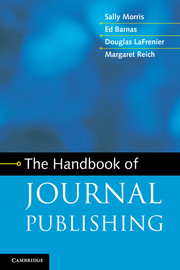Book contents
- Frontmatter
- Contents
- Preface and acknowledgments
- 1 Introduction to journals
- 2 Managing journals
- 3 Editing
- 4 The production process
- 5 Journal metrics
- 6 Marketing and sales
- 7 Fulfillment
- 8 Journal finances
- 9 Subsidiary income
- 10 Contract publishing
- 11 Copyright and other legal aspects
- 12 Ethical issues
- 13 The future of scholarly communication
- Appendix 1 Glossary
- Appendix 2 Resources
- Appendix 3 Vendors
- Index
Preface and acknowledgments
Published online by Cambridge University Press: 05 March 2013
- Frontmatter
- Contents
- Preface and acknowledgments
- 1 Introduction to journals
- 2 Managing journals
- 3 Editing
- 4 The production process
- 5 Journal metrics
- 6 Marketing and sales
- 7 Fulfillment
- 8 Journal finances
- 9 Subsidiary income
- 10 Contract publishing
- 11 Copyright and other legal aspects
- 12 Ethical issues
- 13 The future of scholarly communication
- Appendix 1 Glossary
- Appendix 2 Resources
- Appendix 3 Vendors
- Index
Summary
We, the authors, have all spent many years involved with scholarly and professional journals in the course of our respective publishing careers. And we have all found journals to be one of the most fascinating areas of publishing. Maybe it is because journals are so important to authors; particularly in the sciences, being published promptly in the best available journal is key to a researcher’s future career. Maybe it is because journals represent the cutting edge, where new findings and new ideas are first reported. Maybe it is because journals are not static, but more like a living entity; the publisher can make adjustments to every aspect of a journal, as frequently as necessary, and observe what difference they make (whereas a book publisher has only one chance to make changes – the publication of a new edition – if any!). Maybe it is because journals have been for decades – and still are – in the vanguard of all kinds of exciting developments enabled by the web: developments not just in how journals are produced, delivered, and used, but also in how they are financed. Maybe it is because journals have been at the forefront of significant cultural changes affecting academia, scientific research, publishing, and scholarly communication in general. Probably it is a combination of all these reasons, and more besides.
Whether you, the reader, have come to journals publishing after a spell with books, or are completely new to publishing – or, indeed, if you have some journals experience and want to refresh your knowledge and ideas – we hope that you will find this book a useful resource. You may or may not want to read it from cover to cover; more likely, you will refer to particular sections as you need them. However you use our book, we hope that it will help you to enjoy your experience of journals publishing as much as we have done. Good luck!
- Type
- Chapter
- Information
- The Handbook of Journal Publishing , pp. xi - xiiPublisher: Cambridge University PressPrint publication year: 2013



